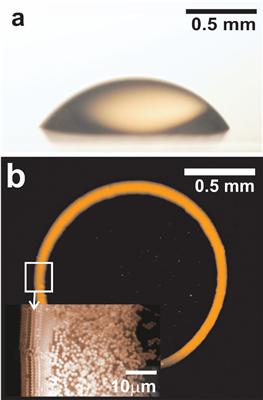The familiar dark ring that remains after a drop of coffee has evaporated develops because the particles in the liquid move towards the outer edge of the drop as the liquid evaporates. This 'coffee stain effect' is also seen in other solutions in which particles are dispersed, so-called colloidal solutions or suspensions. While studying the speed at which the particles move in the solution, University of Twente researchers discovered that there is more to this process than gradual evaporation and liquid transport.
Initially, things proceed very much as one would expect: the drop gradually evaporates. As the liquid evaporates, the balance in the remaining liquid is restored and the particles flow towards the outer edge of ring; the contact line of the drop. At this stage, the particles move very slowly and take time to organize themselves around the circle enclosing the drop. But as the liquid evaporates and reduces, the drop becomes 'flatter'. The same amount of liquid must now move through a surface that is shrinking, causing the speed of the liquid to rapidly accelerate.

'Coffee stain' with ordering at the edge and disorder further within. Credit: University of Twente
At a critical moment, it is rush hour as all the particles try to reach the outside of the ring in record speed. Instead of a neat crystal structure, the result is a chaotic mountain of particles: it resembles the end of the time limit in a game of Tetris.
As time runs out, the same amount of liquid must move through a surface that is rapidly shrinking. The particles no longer have time to organize themselves into a crystal structure according to the so-called Brownian Motion, and are instead forced towards the outside. The researchers show that the moment at which order transits into disorder can be accurately calculated. This is important when evaporation causes new crystal structures to be formed from colloidal solutions, for example.
The research was carried out in the Physics of Fluids department of Professor Detlef Lohse. The department is part of the MESA+ Institute for Nanotechnology at the University of Twente.
Citation: 'Order-to-disorder transition in ring-shaped colloidal stains' by Álvaro Marín, Hanneke Gelderblom, Detlef Lohse and Jacco Snoeijer, Physical Review Letters Phys. Rev. Lett. 107, 085502 (2011) – Published August 15, 2011





Comments